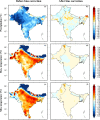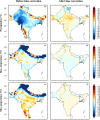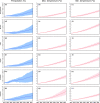Bias-corrected climate projections for South Asia from Coupled Model Intercomparison Project-6
- PMID: 33046709
- PMCID: PMC7550601
- DOI: 10.1038/s41597-020-00681-1
Bias-corrected climate projections for South Asia from Coupled Model Intercomparison Project-6
Abstract
Climate change is likely to pose enormous challenges for agriculture, water resources, infrastructure, and livelihood of millions of people living in South Asia. Here, we develop daily bias-corrected data of precipitation, maximum and minimum temperatures at 0.25° spatial resolution for South Asia (India, Pakistan, Bangladesh, Nepal, Bhutan, and Sri Lanka) and 18 river basins located in the Indian sub-continent. The bias-corrected dataset is developed using Empirical Quantile Mapping (EQM) for the historic (1951-2014) and projected (2015-2100) climate for the four scenarios (SSP126, SSP245, SSP370, SSP585) using output from 13 General Circulation Models (GCMs) from Coupled Model Intercomparison Project-6 (CMIP6). The bias-corrected dataset was evaluated against the observations for both mean and extremes of precipitation, maximum and minimum temperatures. Bias corrected projections from 13 CMIP6-GCMs project a warmer (3-5°C) and wetter (13-30%) climate in South Asia in the 21st century. The bias-corrected projections from CMIP6-GCMs can be used for climate change impact assessment in South Asia and hydrologic impact assessment in the sub-continental river basins.
Conflict of interest statement
The authors declare no competing interests.
Figures









References
-
- Suarez-Gutierrez L, Müller WA, Li C, Marotzke J. Dynamical and thermodynamical drivers of variability in European summer heat extremes. Clim. Dyn. 2020;54:4351–4366. doi: 10.1007/s00382-020-05233-2. - DOI
-
- Knox, J., Hess, T., Daccache, A. & Wheeler, T. Climate change impacts on crop productivity in Africa and South Asia. Environ. Res. Lett. 7(3), 034032 (2012).
-
- Turner AG, Annamalai H. Climate change and the South Asian summer monsoon. Nature Climate Change. 2012;2:587–595. doi: 10.1038/nclimate1495. - DOI
-
- Lobell, D. B. & Burke, M. B. Why are agricultural impacts of climate change so uncertain? the importance of temperature relative to precipitation. Environ. Res. Lett. 3(3), 034007 (2008).
Publication types
LinkOut - more resources
Full Text Sources

